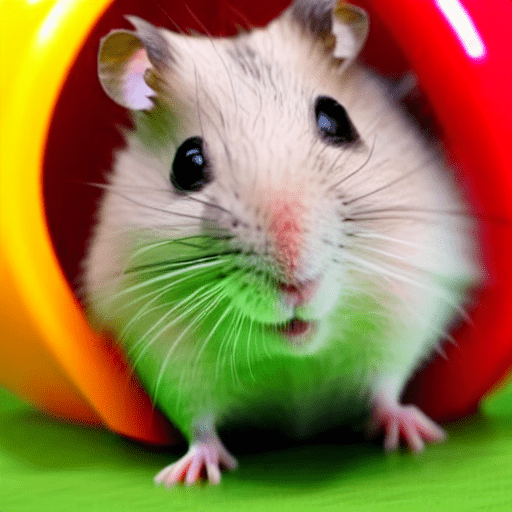How to Tame a Hamster? A Step-by-Step Guide
To tame a hamster, provide a calm and comfortable environment while handling it gently. Introducing a hamster into your home can be an exciting experience.
These adorable small rodents can make wonderful pets with a little patience and understanding. However, taming a hamster requires creating a suitable environment for them and handling them with care. By following a few simple steps, you can build trust and establish a bond with your hamster, allowing them to become more comfortable with you and their surroundings.
We will explore the best methods to tame your new furry friend, ensuring a happy and harmonious relationship between you and your hamster.
Understanding The Nature Of Hamsters
When it comes to taming a hamster, it’s essential to understand their nature and behavior. Hamsters are small and adorable rodents that make popular pets, but each species has its unique temperament. By differentiating between species and understanding their needs, you can establish a strong bond with your furry friend and create a comfortable environment for them. In this article, we will explore differentiating between species and their temperaments, recognizing signs of stress and fear in hamsters, and understanding the importance of patience and consistency in taming.
Differentiating Between Species And Their Temperaments
Hamsters come in several species, each with different temperaments. It’s crucial to familiarize yourself with these variations to provide appropriate care and training. The commonly kept hamster species include:
| Species | Temperament |
|---|---|
| Syrian Hamsters | Generally friendly and solitary |
| Dwarf Hamsters | Often more energetic and can be harder to handle |
| Roborovski Hamsters | Extremely fast and timid |
Please note that individual hamsters can have unique personalities regardless of their species. Spending time with your hamster, observing their behavior, and being patient will help you understand their specific temperament better. This knowledge will guide you in tailoring your training and handling approaches.
Recognizing Signs Of Stress And Fear In Hamsters
Hamsters, like any other living beings, can experience stress and fear. It’s essential to pay attention to their behavior and body language to determine if they are feeling anxious or uncomfortable. Some common signs of stress in hamsters include:
- Increased aggressiveness or biting
- Excessive grooming or fur loss
- Loss of appetite or weight loss
- Excessive hiding or excessive sleep
- Exaggerated startle response
When you recognize any of these signs, it’s crucial to create a calm and soothing environment for your hamster. Minimize loud noises, sudden movements, and excessive handling to help them feel secure. Provide hiding spots and ensure their cage is comfortable with proper ventilation and suitable bedding material.
Understanding The Importance Of Patience And Consistency
Taming a hamster requires patience and consistency. These small creatures may initially display fear or reluctance towards human interaction. However, with time and regular handling, they will grow more comfortable and trusting. Here are some essential tips to keep in mind:
- Start by offering treats from your hand to build positive associations.
- Gradually progress to gently petting your hamster, starting from their back and gradually moving to their head and cheeks.
- Handle your hamster daily for short periods, ensuring their safety and comfort.
- Use a calm and soothing voice when interacting with your hamster.
- Avoid sudden movements or loud noises that may startle or frighten them.
- Be patient and respect your hamster’s limits. Each hamster has their own pace when it comes to taming.
By being patient and consistent in your approach, your hamster will learn to trust you and become more comfortable with handling. Remember, taming a hamster is a gradual process that requires understanding and empathy.
Creating A Comfortable Environment
To create a comfortable environment for taming a hamster, focus on providing a quiet space, offering plenty of hiding spots, and using patience and gentle handling techniques.
When it comes to taming a hamster, creating a comfortable environment is crucial. Hamsters are small, delicate creatures that require specific conditions to feel safe and secure in their surroundings. By setting up the cage with appropriate bedding and accessories, providing a suitable hiding place, and ensuring the cage is in a quiet and secure location, you can help your hamster feel at ease and more receptive to your efforts. In this article, we will discuss each of these aspects in detail to help you create an environment where your hamster can thrive.
Setting Up The Ideal Cage With Appropriate Bedding And Accessories
The first step in creating a comfortable environment for your hamster is to set up the ideal cage. Hamsters require a cage that is large enough for them to explore, exercise, and have plenty of room to move around. A cage with at least 360 square inches of floor space is recommended for Syrian hamsters, while dwarf hamsters can thrive in a slightly smaller space. In addition to size, it is important to choose the right type of bedding for your hamster. Opt for bedding that is safe, absorbent, and comfortable for your hamster to burrow and nest in. Materials such as aspen shavings, paper bedding, or shredded paper are excellent choices. Avoid using cedar or pine bedding, as these can be harmful to your hamster’s respiratory system. When it comes to accessories, provide your hamster with a few essential items to enhance their living environment. A solid exercise wheel will allow them to burn off energy and satisfy their natural instinct to run. Chew toys made of safe materials such as wood or safe plastic can help keep their teeth healthy and prevent boredom. Adding a water bottle and a food dish will ensure your hamster has access to fresh water and a balanced diet.
Providing A Suitable Hiding Place For The Hamster
Hamsters are naturally shy and enjoy having a place to retreat when they feel threatened or need some alone time. Providing a suitable hiding place in their cage is essential for their well-being. This can be achieved by placing a small, enclosed shelter or a hamster house in the cage. These hiding places provide a sense of security and comfort for your hamster, allowing them to relax and feel safe in their environment. Be sure to choose a hiding place that is the appropriate size for your hamster and is made of safe materials that won’t harm them if they chew on it.
Ensuring The Cage Is In A Quiet And Secure Location
In addition to setting up the cage with the right bedding and accessories, it is important to place the cage in a quiet and secure location. Hamsters are naturally skittish and easily stressed by loud noises and sudden movements. Avoid placing the cage in an area where there is a lot of foot traffic or where there are constant loud noises. This will help your hamster feel more at ease and less likely to be startled. Furthermore, it is essential to ensure the cage is secure to prevent any potential escapes. Hamsters are excellent climbers and can squeeze through small openings. Regularly check the cage for any loose wires, gaps, or openings that your hamster could potentially escape from. By creating a calm and secure environment, you are providing your hamster with the peace of mind they need to trust and bond with you.
Building Trust And Bonding
Taming a hamster can be a rewarding process that allows you to build trust and create a strong bond with your furry friend. Taking the time to establish a regular feeding schedule, offering treats and rewards, and gradually introducing your scent to the hamster’s environment are all important steps in building this trust. By following these techniques, you can ensure a positive and enjoyable experience for both you and your hamster.
Establishing A Regular Feeding Schedule To Build Familiarity
One effective way to build familiarity with your hamster is by establishing a regular feeding schedule. Hamsters are creatures of habit and thrive on routine. By consistently feeding your hamster at the same time each day, you are providing a sense of security and predictability for your pet. Consider creating a feeding chart or using an alarm reminder on your phone to help you stick to the schedule. This will not only help you stay organized, but also provide your hamster with a sense of comfort and assurance knowing that food will be provided regularly.
Offering Treats And Rewards To Reinforce Positive Behavior
Another effective way to bond with your hamster is by offering treats and rewards to reinforce positive behavior. Hamsters are naturally curious and responsive to treats, making them an excellent tool for training and building trust. When your hamster displays desired behaviors, such as approaching your hand or responding to commands, reward them with a small treat. This will establish a positive association between the desired behavior and the reward, encouraging your hamster to repeat the behavior in the future. Remember to choose appropriate treats for your hamster, as some types of food can be harmful to their health. Consult with a veterinarian or do thorough research to ensure you are offering safe and suitable treats for your furry friend.
Gradually Introducing Your Scent To The Hamster’s Environment
Hamsters have a strong sense of smell and gradually introducing your scent to their environment can help build trust and familiarity. This process helps your hamster associate your scent with safety and comfort. Start by rubbing your hands gently on a piece of unscented tissue or cloth. Place the scented material near your hamster’s cage or bedding, allowing them to investigate and become accustomed to your scent. Over time, gradually move the scented material closer to the hamster, ensuring they are comfortable and not showing signs of stress. By incorporating your scent into your hamster’s environment, you are reinforcing positive associations and creating a connection built on trust. Remember to wash your hands thoroughly before handling your hamster to avoid overwhelming them with other scents.

Credit: www.wikihow.com
Gaining Initial Contact And Handling
Approaching The Hamster With Slow And Gentle Movements
Using The Hand-slowly-hand Technique To Allow The Hamster To Become Familiar With Your Touch
Gradually Progressing To Lifting And Carrying The Hamster
Encouraging Socialization And Interaction
When it comes to taming a hamster, encouraging socialization and interaction is crucial for fostering a bond with your furry friend. Hamsters are naturally curious creatures, and by providing them with opportunities to engage and interact, you can help them feel more comfortable and build trust.
H3providing Supervised And Controlled Out-of-cage Playtime/h3
One way to promote socialization is by offering supervised and controlled out-of-cage playtime for your hamster. This allows them to explore their environment beyond the confines of their cage, experiencing new sights, sounds, and smells. Before letting your hamster out, ensure the room is hamster-proofed to avoid any hazards or potential escapes. Always keep a close eye on your hamster during playtime to prevent accidents.
H3introducing Toys And Activities To Keep The Hamster Engaged/h3
Introducing toys and activities is another effective way to encourage socialization and interaction with your hamster. Hamsters are intelligent creatures that require mental stimulation to prevent boredom. Consider providing a variety of toys such as chew toys, tunnels, and exercise wheels to keep them engaged. Rotating the toys regularly can keep things exciting and prevent your hamster from getting bored. You can also create DIY toys using hamster-safe materials, offering a creative outlet for both you and your furry friend. Providing a range of textures, shapes, and sizes will keep your hamster intrigued and eager to explore. Remember to always supervise your hamster during playtime to ensure their safety.
H3stimulating The Hamster Mentally With Puzzle Toys And Challenges
In addition to physical toys, stimulating your hamster mentally is equally important. Puzzle toys and challenges can provide mental exercise and prevent boredom. Try hiding treats within puzzle toys or creating maze-like setups with tunnels to encourage problem-solving. Your hamster will enjoy the challenge and engage in mental stimulation while trying to find their way to the reward. Another way to stimulate your hamster mentally is by varying their environment. Rearrange the cage furniture, introduce new hiding spots, or provide different substrates like shredded paper or bedding materials. The change in scenery will keep your hamster curious and engaged, allowing them to explore and adapt to new challenges. Remember, every hamster is unique, and it may take time for them to adjust to new toys and activities. Be patient, offer positive reinforcement, and tailor the level of interaction based on your hamster’s comfort level. With time and consistency, your hamster will flourish in their socialization and interaction efforts.
Is My Hamster Squeaking Because It is Not Tamed?
Is your hamster squeaking? The hamster squeaking mystery revealed – it might not be a result of being untamed. Hamsters communicate through various sounds, and squeaking is one way they express themselves. It could be due to excitement, fear, or even pain. Pay attention to other signs and create a comfortable environment for your little friend to ensure their wellbeing.
Frequently Asked Questions For How To Tame A Hamster?
Are Hamsters Easy To Tame?
Hamsters can be easily tamed. With patience and gentle handling, you can build trust and establish a bond with your hamster. Regular interaction and offering treats can help in making them comfortable and friendly.
How Do You Get A Hamster To Trust You?
To gain a hamster’s trust, spend time near its cage, offering treats, and speaking softly. Avoid sudden movements or loud noises. Gradually extend your hand for the hamster to sniff, then lift it gently. Repeat this process daily to build trust and bond with your hamster.
How Do I Get My Hamster To Tame?
To tame your hamster, start by spending time near the cage so it becomes comfortable with your presence. Then, offer it treats and speak softly to gain its trust. Gradually, try touching it gently and let it explore your hand.
Remember to be patient and calm throughout the process.
How Do You Tame A Hamster Without It Biting You?
To tame a hamster without it biting you, start by approaching it slowly and gently. Offer it treats and speak softly to gain its trust. Gradually introduce your hand and let the hamster sniff and explore it. Avoid quick movements or sudden loud noises, as they can startle the hamster.
Patience and consistency are key in building a positive and trusting relationship with your pet.
Conclusion
Taming a hamster requires patience, consistency, and gentle handling. By gradually building trust and creating a calm environment, you can form a bond with your furry friend. Regular interaction, positive reinforcement, and providing a comfortable habitat are essential in ensuring your hamster feels safe and secure.
Remember, every hamster is unique, so it’s important to be patient and understanding throughout the taming process. Happy taming!



One Comment